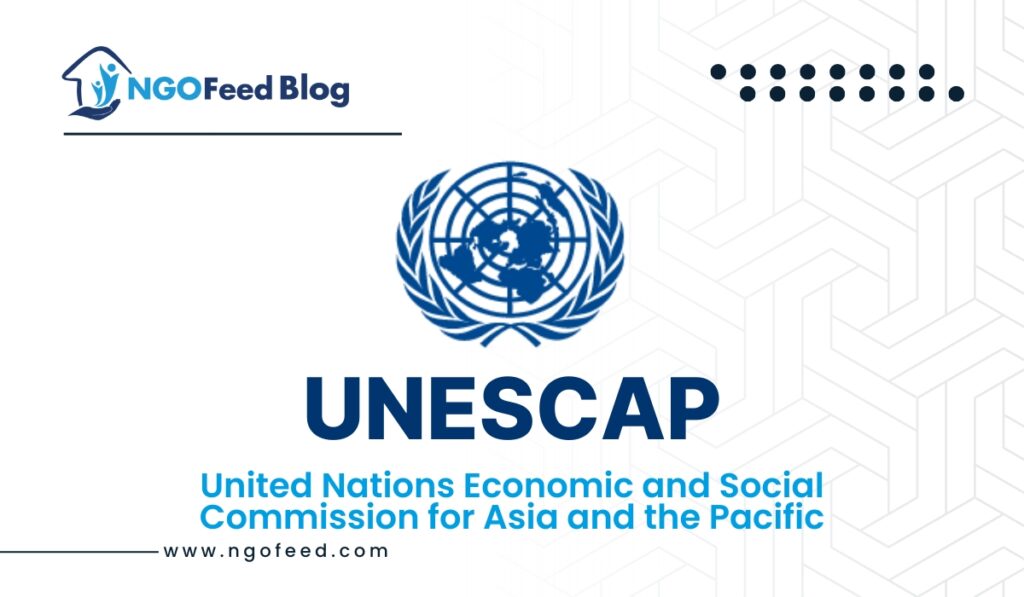UNESCAP Full Form: The United Nations Economic and Social Commission for Asia and the Pacific cooperation among countries to achieve inclusive and sustainable development. The United Nations Economic and Social Commission for Asia and the Pacific (ESCAP) is one of the United Nations Economic and Social Council’s five regional commissions. It was founded to boost economic activity in Asia and the Far East and strengthen economic ties between the region and the rest of the world. Throughout this article, you will get information about the UNESCAP, such as its history, area of work, scope, publication, function etc.
| Index 1 UNESCAP Overview 2 What is UNESCAP 3 History 4 Area of Work 5 Scope 6 Publications 7 Member States 8 Frequently Asked Questions (FAQs) |
UNESCAP Overview
Before starting the complete information about IDA, let’s look at the short overview.
| UNESCAP | United Nations Economic and Social Commission for Asia and the Pacific (ESCAP) |
| Headquarters | Bangkok, Thailand |
| Formation | 28 March 1947 |
| Executive Secretary | Armida Salsiah Alisjahbana |
| Parent Organization | United Nations Economic and Social Council |
| Website | www.unescap.org |
| Member | 53 Member States and 9 Associate members |
What is UNESCAP
The United Nations Economic and Social Commission for Asia and the Pacific (ESCAP) is one of five regional commissions under the United Nations Economic and Social Council jurisdiction. It was established to increase economic activity in Asia and the Far East and promote economic ties between the region and other regions.
The Commission has 53 member states and nine associate members, mainly from the Asia and Pacific. In addition to countries in Asia and the Pacific, members of the Commission include France, the Netherlands, the United Kingdom, and the United States.
Read also:
History
The Commission was first established by the Economic and Social Council on 28 March 1947 as the United Nations Economic Commission for Asia and the Far East (ECAFE) to aid in post-war economic reconstruction. Its primary mandate was to “initiate and participate in measures to facilitate concrete action for Asia and the Far East”.
On 1 August 1974, it was renamed the Economic and Social Commission for Asia and the Pacific (ESCAP) by the Economic and Social Council to reflect the Commission’s work and its geographic location.
Area of Work
- Investment and User Engagement
- Skills Development
- Quality Assurance and Trust in Statistics
- Statistical Business Process Modernization
- Integrated Statistics and Analysis
Scope
The Commission works to address some of the most critical challenges facing the region through result-oriented projects, technical assistance and capacity building to Member States in the following areas:
- Macroeconomic policy and development
- Trade and investment
- Transport
- Social development
- Environment and sustainable development
- Information and communications technology and disaster risk reduction
- Statistics
- Sub-regional activities for development
- Energy
Additionally, the Commission provides its member states a platform to promote regional cooperation and collective action to advance the 2030 Agenda for Sustainable Development.
UNESCAP’s commitment to promoting gender equality and empowerment.
- Recognition of equality between men and women is crucial for sustainable development.
- Addressing root causes of gender inequality: discrimination, violence, lack of access to education and healthcare.
- Collaboration with member countries to identify and rectify these issues.
- The Asian and Pacific Conference on Gender Equality and Women’s Empowerment.
- Bringing together stakeholders from the region to discuss and plan initiatives.
- Held multiple times since 1999.
- A platform for raising awareness and advocating for women and girls’ rights.
Addressing Earthquake Risks
- Key natural disasters include earthquakes, typhoons, and flooding.
- Initiatives aim to help member countries prepare for and respond to disasters effectively.
- Around every two years, the Asia-Pacific hazard Report gives an overall picture of the region’s hazard risk.
- Strategies for risk reduction are identified in the report.
- The report serves as a platform for discussions and actions on disaster resilience and risk reduction.
Publications
- Asia-Pacific Countries with Special Needs Development Report
- Asia-Pacific Development Journal
- Asia-Pacific Disaster Report
- Asia-Pacific Trade and Investment Report
- Economic and Social Survey of Asia and the Pacific
- Review of Development in Transport in Asia and the Pacific
- SDG Progress Assessment Reports / Statistical Yearbook for Asia and the Pacific
Read also:
Member States
The countries listed below have all full members of the commission:
| Afghanistan | Papua New Guinea |
| Armenia | Philippines |
| Australia | Republic of Korea |
| Azerbaijan | Russian Federation |
| Bangladesh | Samoa |
| Bhutan | Singapore |
| Brunei Darussalam | Solomon Islands |
| Cambodia | Sri Lanka |
| China | Tajikistan |
| Democratic People’s Republic of Korea | Thailand |
| Fiji | Timor-Leste |
| France | Tonga |
| Georgia | Turkey |
| India | Turkmenistan |
| Indonesia | Tuvalu |
| Iran (Islamic Republic of) | United Kingdom of Great Britain and Northern Ireland |
| Japan | United States of America |
| Kazakhstan | Uzbekistan |
| Kiribati | Vanuatu |
| Kyrgyzstan | Viet Nam |
| Lao People’s Democratic Republic | Micronesia (Federated States of) |
| Malaysia | Mongolia |
| Maldives | Myanmar |
| Marshall Islands | Nauru |
| New Zealand | Nepal |
| Pakistan | Netherlands |
| Palau |
Conclusion
The United Nations Economic and Social Commission for Asia and the Pacific (UNESCAP) is one of the most important groups working to promote sustainable and inclusive growth in the area. UNESCAP is very important for tackling important issues like economic growth, social progress, environmental sustainability, and crisis resilience. It does this through its long past, diverse membership, and wide range of work areas. UNESCAP continues to be a leader in cooperation and progress, working for a better and more resilient future for everyone in the Asia-Pacific area. Its goals include supporting gender equality and women’s rights, as well as lowering the risks of natural disasters.
Frequently Asked Questions (FAQs)
What is the Full form of UNESCAP?
United Nations Economic and Social Commission for Asia and the Pacific (UNESCAP).
How many countries are in the United Nations Economic and Social Commission for Asia and the Pacific (ESCAP)?
There are 53 Member States and 9 Associate members of the UNESCAP.
Who is the head of the UNESCAP?
Armida Salsiah Alisjahbana is the Executive Secretary of the United Nations Economic and Social Commission for Asia and the Pacific (ESCAP).
Read also:



